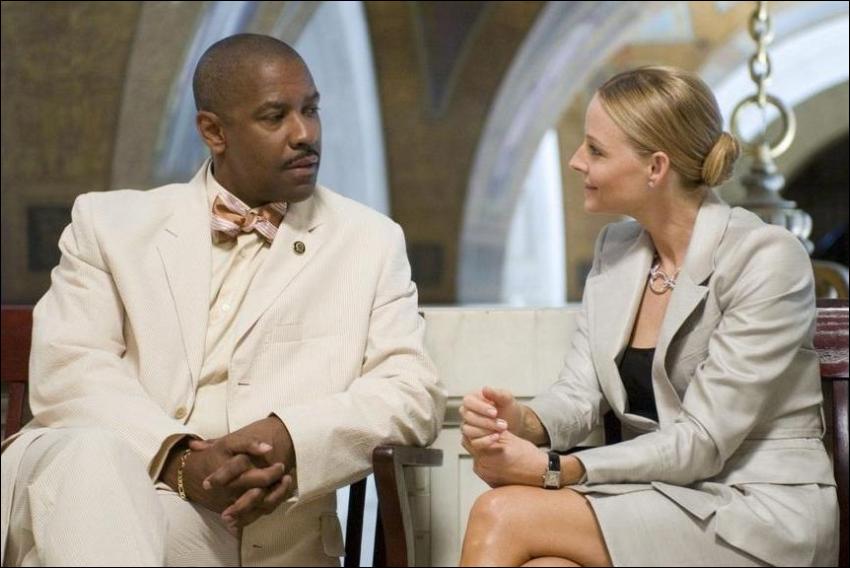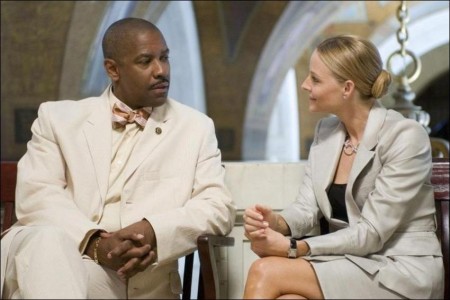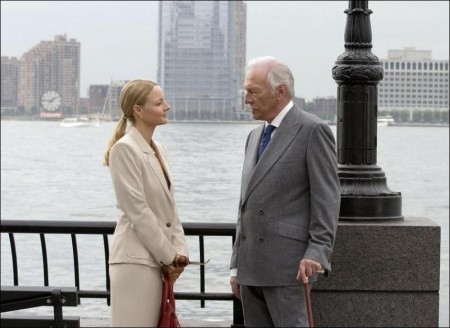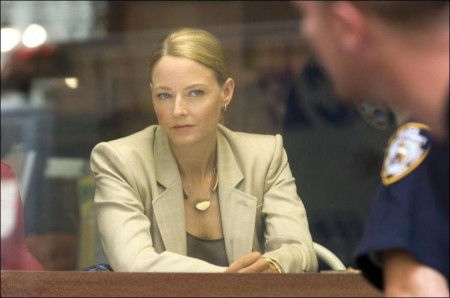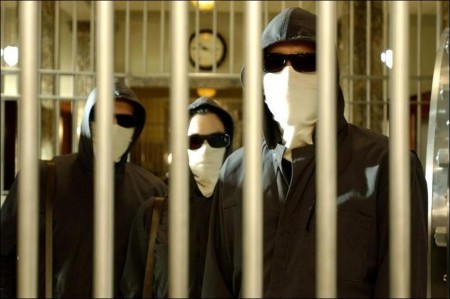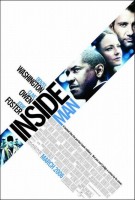Tagline: No detail is unimportant. No clue is a throwaway.
Acclaimed actors Denzel Washington, Clive Owen and Jodie Foster come together to explore the lure of power, the ugliness of greed and the mystery of a perfect robbery in a combustible new crime drama from Universal Pictures and Imagine Entertainment – Inside Man.
The powerhouse actors play tough New Yorkers who must outwit one another to protect competing interests in this skillfully penned and tightly helmed thriller. With on-screen presence that demands rapt attention, Washington, Owen and Foster portray characters who present every piece of an interlocking puzzle, but is every piece what it seems?
The three key players-Washington as a newly promoted detective who must rise above a corruption scandal, Owen as a brilliant criminal who upends what we think we know about a bank robbery and Foster as a mysterious Manhattan power broker who gets exactly what her clients pay top dollar for-collide in Inside Man, in a mainstream potboiler for Spike Lee, who teases the audience with tricks of camera and twists of plot.
By its didn’t-see-that-coming conclusion, Inside Man reveals itself as anything but your typical thriller. It all starts out simply enough: four people dressed in painters’ outfits march into the busy lobby of Manhattan Trust, a cornerstone Wall Street branch of a worldwide financial institution. Within seconds, the costumed robbers place the bank under a surgically planned siege, and the 50 patrons and staff become unwitting pawns in an airtight heist.
NYPD hostage negotiators Detectives Keith Frazier (Denzel Washington) and Bill Mitchell (Chiwetel Ejiofor) are dispatched to the scene with orders to establish contact with the heist’s ringleader, Dalton Russell (Clive Owen), and ensure safe release of the hostages. Working alongside Emergency Services Unit (ESU) Captain John Darius (Willem Dafoe), all are hopeful that the situation can be peacefully diffused and that control of the bank and release of those inside can be secured in short order.
But things don’t progress as planned. Russell proves an unexpectedly canny opponent-clever, calm and totally in command-a puppet master with a meticulous plan to disorient and confuse not only the hostages, but also the authorities. Outside, the crowd of New Yorkers grows as the situation becomes increasingly tense, with Frazier’s superiors becoming more concerned about his ability to keep the standoff from spiraling out of control.
The robbers appear to consistently be one step ahead of the police, outwitting Frazier and Darius at every turn. Frazier’s suspicions that more is at work than anyone perceives are justified with the entry of Madeline White (Jodie Foster), a power player with shadowy objectives, who requests a private meeting with Russell. The chairman of the bank’s board of directors, controlling entrepreneur Arthur Case (Christopher Plummer), is also uniquely interested in the moment-to-moment happenings inside the branch.
But just what are the robbers after? Why has nothing worked to alleviate the standoff, which stretches on hour after hour? Frazier is convinced that invisible strings are being pulled and secret negotiations are taking place as the powder keg situation grows more unstable by the moment. With loyalties and motives called into question, the detective engages in a risky game of cat-and-mouse-but with the rules of the game ever changing, one wrong move may take the volatile match closer to a disastrous and deadly conclusion.
Joining Lee behind the camera is a cadre of cinema craftsmen-many of whom have previously collaborated with the filmmaker-including director of photography Matthew Libatique (Requiem for a Dream), production designer Wynn Thomas (Cinderella Man), editor Barry Alexander Brown (Do the Right Thing) and composer Terence Blanchard (Malcom X). Inside Man is executive-produced by Daniel M. Rosenberg (Novocaine), Jon Kilik (25th Hour), Karen Kehela Sherwood (A Beautiful Mind) and Kim Roth (Insomnia).
The Puzzlemakers
Academy Award-winning producer Brian Grazer and Oscar-nominated visionary Spike Lee first met at the Academy ceremonies many years ago. Lee had been nominated in 1990 in the category of Best Original Screenplay for Do the Right Thing, and Grazer had been nominated in the same category for Splash five years prior. Throughout the years, they’d met intermittently in the hopes of collaborating on different projects, but nothing had come to fruition. Inside Man presented just the opportunity for these history-making filmmakers to finally work together.
Grazer had recently purchased a cunningly written thriller titled Inside Man from newcomer Russell Gewirtz, to be made at Universal Pictures. While scouting for a director who could take this smartly written action drama from page to screen, a chance meeting resulted in Lee’s reading the script and signing on to direct the project.
Not often does a story come along that can challenge a seasoned director so completely. Lee, who has made hard-hitting social commentary films for the past few decades, welcomed the opportunity to helm a smart, sophisticated, pressure-cooker thriller. He lauds, “Russell Gewirtz wrote a fresh, intriguing take on the genre of the bank robbery heist, and I liked the script and really wanted to do it. Dog Day Afternoon is one of my favorite films, and this story was a contemporary take on that kind of movie.”
Grazer recognized that with Inside Man, the time had finally come for the long-discussed collaboration with Lee. Grazer recalls, “When we met this time, Spike said, `We’ve had meetings and false starts, but I promise you we’re going to have a great finish.’ He looked me straight in the eye, grabbed my arm and said, `Let’s do it.’”
Grazer was as excited about the script as he was about working with Lee. “For me, originality is the thing,” he explains. “A script has to make me feel curious, and at no point can I feel complacent. In this story, it was the red herring aspect that I liked-not knowing why things were happening and later having everything revealed in such a satisfying and surprising way. These twists and turns really took the model of a heist film in a new and interesting direction.”
Grazer and Lee’s first-time partnership wasn’t the film’s only new collaboration. For a project to unite such an award-winning, accomplished assembly of cast and filmmakers, one might assume the crafty screenplay had come from a veteran screenwriter. But Russell Gewirtz holds the rare distinction of seeing his first original screenplay produced, directed and performed by most distinguished talents in the business.
After dabbling in several careers, Gewirtz spent several years living in Europe and South America, where he says the idea for Inside Man gelled. “I had some version of this story in my head for five or six years, and then crucial elements started coming together. I bounced the pitch off my good friend Daniel Rosenberg [later the film’s executive producer].” After over a year of work on Gewirtz’s script, Rosenberg shopped the finished version to a handful of the top Los Angeles agencies. One of those agents sent it to Imagine, and the rest is Hollywood history.
Reflecting on the process, the writer notes, “To say that I’ve been spoiled by this would be an understatement. It was surreal to come to the first table reading and sit down to Denzel, Clive, Jodie and Christopher delivering lines that I wrote. Then we begin filming, and I watch Spike orchestrate the entire production.” Not only was Gewirtz impressed by the all-stars bringing his words to film, he was amazed at the production value of the Inside Man set. “The team imagined and constructed an entire bank based on a few lines I put to paper four years ago. Unbelievable.”
Locking Up the Players: Cops Meet Robbers
Grazer and Lee knew they had a story on their hands that, while quite intelligent, could be a challenge to shoot with all of its texture and surprises intact. Gewirtz’s script cut systematically among Frazier, Russell and White’s storylines, weaving in key details at unexpected moments. For example, Dalton Russell introduces the film with direct address to the audience, whom he encourages to “pay strict attention to what I say, because I choose my words carefully, and I never repeat myself.” His dictum holds true as we chase the players across darkened rooms and corridors of power to see who will be scammed by whom, and who will wind up on top. There was no way this film could be done without a stellar cast of acting all-stars.
Inside Man presented Denzel Washington his fourth collaboration with Lee, following He Got Game, Mo’ Better Blues and Malcom X, which netted Washington an Oscar nomination for his volcanic central performance. Acknowledging their creative shorthand honed in their joint ventures, Washington says, “Spike and I really solidified on Malcolm X. He knows what he wants; he’s ready to go. He’s prepared, and he lets me do my thing. He’s also a very sophisticated filmmaker in his shot selection. And I now have an even deeper appreciation for his abilities, having tried to put a film together myself.” (Washington’s directorial debut, Antwone Fisher, earned numerous awards, including one for newcomer Derek Luke [for Best Actor from the Independent Spirit Awards.]
Double Oscar winner Washington came to Inside Man fresh from a Broadway run as Brutus in Julius Caesar (he had one week off between the play’s close and the film’s start), and somewhat surprisingly, found similarities in the two projects. He offers, “Obviously, Shakespeare is all about the language, and I think it actually helped me prepare for Frazier-Russell’s script is heavy with great dialogue. My character does a lot of talking! I kind of thought of Frazier as Brutus goes to Brooklyn. For me, there is a certain rhythm and cadence of New Yorkers, and this gave me the opportunity to play a New York kind of guy who’s going through a lot while dealing with this smart and challenging adversary.”
The chance to work with Washington was equally appealing for Lee. “We had last worked together on He Got Game, and we were both eager to work together again-I think our track record together speaks for itself.”
Like Washington, the other actors who make up the ensemble cast-Clive Owen, Jodie Foster, Christopher Plummer, Willem Dafoe and Chiwetel Ejiofor-count the chance to work with Lee among their chief reasons for signing on.
“We would talk about our dream cast,” notes Grazer, “and Spike would call them directly. He called Denzel, who said `Yes’ right away. He went to Clive Owen and got him on board and was key in drawing in Jodie Foster.” “Right from the start, Spike made such an impact with his films. I was very taken with him,” says Owen, who agreed to play the mastermind of the heist, Dalton Russell, the nemesis to Washington’s Detective Frazier. “I love the fact that he’s a bold, courageous director who has made some very dynamic, controversial movies that stir people up.”
Though flattered by the adulation from the cast, Lee nonetheless credits Gewirtz’s remarkable script with attracting the film’s impressive talent. “Let’s face it, they’re not going to be in the film if we’re shooting the phone book, so a lot of the credit of what brought us together goes to the script…and just great timing.”
Owen nearly turned the film down, citing concerns over his character’s disguise of a hood, mask and glasses, which obscure his eyes and face for a good portion of the film. “To play whole scenes where you’re masked, you’ve got on sunglasses and you’re wearing a hood is very weird, because a lot of acting is often through intent, and intent is shown through the eyes. To suddenly have that taken away and have this big barrier there was very disarming.” In classic Spike Lee style, the filmmaker romanced the star and worked at convincing him to take the role during a New York Knicks game, with Lee providing courtside seats. Shortly after the final whistle had been blown, Owen had been won over.
“Clive is great and took on a big risk because the audience can’t see his face,” Lee explains. “Denzel said it was hard for him to act with Clive because he fed off Clive’s expressions, and there were scenes when his face was completely masked.” To give the actors more “face” time and allow the audience into the clever robber’s head, filmmakers carefully reviewed the script and found places where Owen’s character could be filmed unmasked.
“Clive is intense and he has a great presence,” adds Grazer. “He’s also a formidable opponent to Denzel, which is hard to find because Denzel has so much charisma and strength.”
Owen is quick to share, “To play opposite Denzel Washington was a huge reason why I signed on. I mean, he’s been one of the strongest leading men in cinema for the last 10 years.”
Jodie Foster’s stellar film career has placed her in the rare position of being able to pick and choose from the best possible roles. Having played a wide range of characters in a career that spans nearly all four decades of her life (she began in commercials at the age of three), she says at this point it’s about working with filmmakers she admires. “Spike is somebody who always fascinated me, and I’ve loved his movies. I’ve always wanted to be involved in something he’s making. Basically, I never thought I would because it didn’t seem like his stories or subject matter were ever going to include me. So, I’m just as excited as I can be.”
“Jodie brings great artistry, class and intelligence to a film. She brings the pedigree,” says Lee, citing the brilliance of her work in such projects as Martin Scorsese’s Taxi Driver and Jonathan Demme’s The Silence of the Lambs.
Equally appealing for the two-time Oscar-winning actress was the opportunity to play a character who is a sophisticated, smooth troubleshooter…one who sorts out the dirty laundry of some of New York’s most elite and powerful citizens without breaking a sweat. “I haven’t played anybody in a really long time that wears nice clothes and makeup and doesn’t get too dirty,” Foster jokes. “I also like that there’s a relaxed kind of witty quality to her. All the while being very strong, not having to raise her voice very much, not having to yell at anybody-she’s got authority. There’s seductiveness, a charm, if you will, to her ability to get into people’s psyches that’s been immensely fun to play. It all went way too fast for me.”
Washington enjoyed playing opposite Foster, both as actor-to-actor and character-to-character. He notes, “There is a mutual respect between us as performers, which is somewhat similar to our on-screen relationship…though, obviously, not nearly as antagonistic. Both of our characters are good at what they do, and they are both committed to getting their jobs done, no matter what the cost. Power respects power.”
Christopher Plummer plays Arthur Case, a powerful business mogul and philanthropist who hires Foster’s character to navigate a potentially career-ending situation. “I play this wonderful, rich head of all sorts of organizations-I suppose a kind of `Enron creature’-who runs banks and other world businesses. He has tentacles everywhere, and he’s a real son-of-a-bitch who’s trying to keep a secret in the process,” says Plummer.
A fan of Lee’s work, Plummer (who worked with Lee and Washington on Malcolm X) says spending the summer working with Lee in New York and living “practically down the road was a delightful opportunity I could not pass up.” Plummer, who has worked with scores of directors around the world on countless films and on more than a 100 television programs, praised Lee’s directing style. “There’s none of the usual bull that you have to go through with directors who come in and over-intellectualize everything and go into long, long analyses about things,” says Plummer. “With Spike, we just shoot it and get on with the story.”
“People prefer working this way,” says Lee, “because we don’t work 16-, 17-, 18-hour days. We try to shoot from six in the morning to six at night. We feel it helps actors give their best performances when they can head home in the evening to their families and their lives.”
Foster comments, “To take a movie, I have to feel that it’s significant enough to be away from my kids for a long period of time. While Inside Man is definitely that, it was also like a little vacation, working with Spike and all these wonderful actors in a city that I like to call home as well.”
Two-time Oscar® nominee Willem Dafoe-who portrays the veteran ESU Captain John Darius-shares, “I live in New York City, and I don’t get to work that much here. And I’ve always liked Spike’s work. He’s asked me to do little small things before, but they never worked out, schedule-wise. So I was happy to work on this film.”
Dafoe joined with the cast in praising the authentic feel of the dialogue and storyline that saturates the screenplay, courtesy of native New Yorker Gewirtz. Dafoe says, “The cool thing about this story is that, in a way, it’s a whole world-it’s got a little bit of all the different threads that make up New York City. It’s not self-conscious about it, but you shut the doors on a bunch of people in a New York bank, and you’ve got a random sampling of society. Shut the doors and that’s the whole world you’ve got”
Dafoe, like his fellow cast members, saw an opportunity to work within the frame of a classic genre film while bringing new elements to the formula. He explains, “The story is basically about the perfect crime, a bank robbery… at least, on the surface. But it’s also about a lot of other things, some of them not as apparent: it’s about the city; it’s about authority; it’s about the mentality of crime, and it’s about power…and payback.”
Chiwetel Ejiofor collaborates with Lee for the second time (having appeared in the director’s She Hate Me), playing Detective Bill Mitchell, partner to Washington’s Detective Frazier. Grateful for Lee’s loyalty to artists, both in front of the camera and behind the scenes, Ejiofor recalls, “I heard about the film as Spike and I went to a Yankees game. He said he wanted me to read the script and see if I wanted to be involved. Spike asks so many people to come back and work with him in different capacities and as different types of characters.”
Preparing for their detective roles was a three-pronged process for Washington and Ejiofor. First, they spent time in rehearsal, reading scenes, running lines and working at understanding their relationships. Secondly, they (along with many others in the cast and crew) attended Spike Lee’s ad hoc cinema study class, where he screened numerous New York-set thrillers and heist films (including the classics Serpico and Dog Day Afternoon, starring Al Pacino and directed by New York director Sidney Lumet).
“I picked films that had some resemblance to what we were trying to do as far as subject matter, look and genre,” explains Lee. “It’s something we’ve done the last two or three films and it becomes a social event. It’s also a bonding thing among the cast and crew. A lot of times, we have young people who’ve never seen these films, so it’s almost a cinema class as well.”
Lastly, Washington, Ejiofor, Dafoe and others met and worked with select members of the New York Police Department, including NYPD consultant Detective Neil Carter and ESU special consultant Detective Ed Bogdanowicz. Ejiofor shares, “We went out and met policemen and detectives who worked with us throughout the film. They broke down their feelings that they experienced during some really important days and some really bad ones-especially those that involved civilians and hostage situations. The information they shared was incredibly valuable.”
Washington praised both Ejiofor and Owen (who are British) for rising to the challenge of playing New York characters with such realism. He comments, “I understand the work it takes to get those accents right. They’re both not just professional, but also very, very good actors.”
Eyeing Red Herrings: Camera Twists of Inside Man
Gewirtz’s bracing, intellectual script offered multiple challenges for filmmakers designing and lensing a thriller. How could Lee keep the audience engaged when the majority of scenes were shot on one location? How could he achieve a “thriller feel” when the fastest exchanges were in peppered dialogue, not car chases or shootouts? Knowing that his subdued set would have to take advantage of both his actors’ rapport and tight editing, Lee didn’t waste a minute in preparing for the challenges.
For the film, Lee and director of photography Matthew Libatique once again utilized a technique Lee had successfully employed on several previous films-shooting a scene simultaneously with two cameras that capture both actors participating. Although it affords a unique opportunity for obtaining more useful footage and no need to set up for reaction shots, the technique requires a deft hand, and many directors are reticent to use it.
This new filming challenge intrigued Owen, who observes, “I imagine that it’s a DP’s nightmare that Spike shoots both ways at the same time. But it’s great for us, the actors, because it means you’re always on, there’s none of that off-camera sort of thing going on. It means that two actors go head-to-head at the same time, which creates the opportunity for things to be very alive.”
For Lee, a two-camera filming approach is a win-win for everyone. “We think you get better performances from actors when they’re on,” he explains, “because you might be that actor who has to wait around until late in the day to shoot and by then, the performance is tired. So we get actors to set, through makeup, hair and wardrobe, and after we’re done lighting, we’re ready for them.”
An example of the technique’s efficacy can be found in the scene where Russell needles Frazier’s team by leading them to believe he and his fellow bank robbers are Albanian criminals. Lee takes the audience in and out of the mobile command center (MCC) with jarring shots on players from multiple angles, allowing us to see their distraction and confusion. Only by coincidence does Frazier realize that Russell is playing him, but once again…it’s too late.
In the pivotal scene where Frazier discovers that Russell has been taping the MCC conversations, Frazier blows up in a barely controlled rage of which few actors are capable. Lee provides a narrow window for the audience to remain transfixed on Washington as we watch a police officer at the end of his rope, and possibly the end of his career. With rapid-fire camera cuts and close-ups of his hands, we see Frazier rip apart the bugged device, slam it onto the table and grab the walkie to abort a bank strike mission by the NYPD SWAT team. As the detective spirals out of and tries to regain control of the situation, the director helps the audience feel his agony.
Russell asks riddles of the cops to “guarantee” hostage safety, toys with their sympathy for the victims by threatening to kill one hostage per hour and proceeds to make the crime scene a suspenseful hell for Frazier and the rest of the NYPD officers on site. Russell, determined to finish his mission, creates the necessary evils to distract his would-be captors from the realization that he never had any intention of actually robbing the bank of its cash and bonds.
In a dizzying and dark sequence spliced with muffled voice orders from behind Russell’s mask, we jump from one bank office to the next as the would-be bank robbers walk hostages from room to room. With cameras constantly switching up-Lee had multiple units on actors almost the entire shoot-we lose track of who the good guys are and who the bad ones are. This jarring, unsettling camerawork begins to make the uninitiated audience feel as helpless as the cops.
Throughout the film, Lee inserts post-bank-break-in testimonials from the hostages as he unfolds the narrative. Detectives Frazier and Mitchell interview, prod and cajole the employees and customers to try and understand the events that unfolded in the bank and why a) no money was stolen from Manhattan Trust by Russell and his team and b) the robbers are nowhere to be found. While this tactic could have proved distracting to the storyline, it actually keeps the audience’s attention rapt for the film’s run.
As the film unfolds, Frazier (and the audience) begin to regain control when he flexes police authority over the coolly cruel broker Madeline White, who refuses to be turned down as an unwanted incident participant. Chastised for delving into matters that are “frankly above his pay grade,” Frazier probes and pushes her and the unethical mayor until he finds answers, playing the very same bureaucrats who underestimated him. The director assists Frazier’s ascent from confusion to enlightenment by giving Washington a more and more assertive, commanding presence on-screen as he catches on to the backstory.
Indeed, Lee keeps surprising us with a quick hand completing his lightning-fast shots and deft edits. Producer Grazer summarizes, “Inside Man is a thinking man’s heist film, a twisty, turny thriller. It is designed to be entertaining, where audiences are at the edge of their seat-with combustible moments between this genius character played by Clive Owen and a cop we’re not certain has the command, knowledge or wisdom to challenge a criminal mastermind.”
Designing Bank Vaults and Corridors of Power
Principal photography for Inside Man took place entirely on location in New York City and ran nearly two months between June and August of 2005. Veteran production designer Wynn Thomas led the design team in creating sets for the film. His collaborations with Lee date back 20 years, all the way to Lee’s breakthrough independent feature film, She’s Gotta Have It. Those years have gone a long way to building a trusting partnership with little reason for detailed explanations.
“We’re so comfortable, we’re like an old married couple,” says Thomas of his ongoing working relationship with Lee. “We talk for about five minutes at the beginning of the film and I don’t have to talk to him again for the rest of the picture. He knows he can trust me to give him what he wants.”
One example is the set Thomas designed for Detective Keith Frazier’s apartment, which he describes as very masculine and rich and highly monochromatic in its many hues of brown. “It’s chocolate on chocolate on chocolate, “ says Thomas, “and it was my instinctual response to his living space. When Spike saw it, he said it looked like a Blue Note album cover, with all those similar tonalities.”
Thomas and his team got to work designing interior sets for a wide variety of locations-such as the NYPD headquarters, the mobile command center, an interrogation room, the bank’s basement (where the hostages are held) and Frazier’s apartment.
Scouting had zeroed in on the perfect stand-in for Branch Number 32 of Manhattan Trust-the bank’s main set was located in a former Wall Street bank that had been closed and later repurposed as a cigar bar. Thomas and his team were responsible for a major undertaking, charged with restoring the former bank to its 1920s grandeur and architectural integrity. “This movie takes place in the world of old New York money,” Thomas explains, “so we had to do extensive renovations to make the first floor look like an old-fashioned institution of money and power-it’s where the robbers first hold their hostages.”
Says Lee, “We were sweating at first, because the bank set was one of the last ones we found-and it was the most important. Without a bank, we didn’t have a movie. But everything ended up going very smoothly. We shot in the heart of Wall Street in a bank that had been closed down. It was like having a back lot in the middle of Wall Street.”
Office space for Christopher Plummer’s character, Arthur Case, was also located in an older building that formerly housed customs offices. Plummer notes, “It’s just the sort of office that J. Pierpont Morgan or Andrew Carnegie would have had. It’s just something extraordinary. The space literally presents Case’s power, so I found that part of my character was simply playing very cool about everything. You don’t have to push the power, because it’s all around you.”
Inside Man was the second production to shoot at the newly established Steiner Studios in Brooklyn, New York. The 15-acre facility at the historic Brooklyn Navy Yard is the largest production facility east of Los Angeles, newly built from the ground up. Its massive size allowed for all of the interior sets to be housed in one place.
Economy of shooting was something that Lee very much took to heart. Commenting on Lee’s commitment and focus, producer Grazer observes, “He’s very economic and wouldn’t even eat lunch. He’d just stand in the street and plan his next shot.”
Lee attributes his work ethic to his parents, most especially his mother, who has since passed away. Lee closes, “My mother was an art teacher and my father is a jazz musician, and they instilled in their children a strong foundation. My mother said, `Never be satisfied. Do your best, but keep striving onward and upward.’ I try and bring that to every movie I make.
These production notes provided by Universal Pictures.
Inside Man
Starring: Denzel Washington, Clive Owen, Jodie Foster, Willem Dafoe, Chiwetel Ejiofor, Christopher Plummer, Ashlie Atkinson
Directed by: Spike Lee
Screenplay by: Russell Gewirtz
Release Date: March 24th, 2006
MPAA Rating: R for language and some violent images.
Studio: Universal Pictures
Box Office Totals
Domestic: $88,513,495 (48.0%)
Foreign: $95,862,759 (52.0%)
Total: $184,376,254 (Worldwide)
